Papers by Juan Lopez-alvarenga
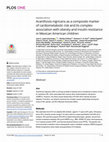
PLOS ONE, 2020
Aim Acanthosis nigricans (AN) is a strong correlate of obesity and is considered a marker of insu... more Aim Acanthosis nigricans (AN) is a strong correlate of obesity and is considered a marker of insulin resistance (IR). AN is associated with various other cardiometabolic risk factors (CMRFs). However, the direct causal relationship of IR with AN in obesity has been debated. Therefore, we aimed to examine the complex causal relationships among the troika of AN, obesity, and IR in Mexican Americans (MAs). Methods We used data from 670 non-diabetic MA children, aged 6-17 years (49% girls). AN (prevalence 33%) severity scores (range 0-5) were used as a quasi-quantitative trait (AN-q) for analysis. We used the program SOLAR for determining phenotypic, genetic, and environmental correlations between AN-q and CMRFs (e.g., BMI, HOMA-IR, lipids, blood pressure, hs-C-reactive protein (CRP), and Harvard physical fitness score (PFS)). The genetic and environmental correlations were subsequently used in mediation analysis (AMOS program). Model comparisons were made using goodness-of-fit indexes.
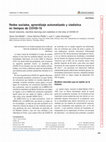
La mayor causa de mortalidad a lo largo de nuestra historia no han sido los conflictos bélicos, s... more La mayor causa de mortalidad a lo largo de nuestra historia no han sido los conflictos bélicos, sino las enfermedades infecciosas. En el año 2009, la influenza H1N1 nos alertó sobre las pandemias, pero al parecer no logramos aprender mucho. La pandemia de COVID-19 nos muestra una vez más nuestra vulnerabilidad y nos invita a reflexionar sobre las herramientas que tenemos para contener pandemias similares en el futuro. El virus causante de la COVID-19, agente infeccioso de la presente pandemia, pertenece a la gran familia de coronavirus que habitan en muchas especies de animales, incluidos camellos, vacas, gatos y murciélagos. En ocasiones, los coronavirus animales infectan a personas, como lo sucedido con el MERS-CoV (síndrome respiratorio de Medio Oriente por sus siglas en inglés) o con el SARS-CoV (síndrome respiratorio agudo grave por sus siglas en inglés), y ahora con este nuevo virus, llamado SARS-CoV-2. El SARS-CoV-2 es un beta-coronavirus, como el MERS-CoV y el SARS-CoV, que ...
Cirugía y Cirujanos, 2021
En esta revisión se describen el historial de vacunación, los diferentes tipos de vacunas y cómo ... more En esta revisión se describen el historial de vacunación, los diferentes tipos de vacunas y cómo la cobertura de vacunación se ha visto afectada por la pandemia actual de COVID-19. Se analiza la efectividad de las vacunas en condiciones metabólicas del huésped, especialmente cuando las personas han perdido su inmunocompetencia, como los pacientes con enfermedad renal crónica que están en tratamiento de diálisis. Las vacunas se producen con una variedad de métodos industriales, modificando los costos. El nuevo campo de la vacunómica incluye el conjunto de respuestas inmunitarias, los niveles satisfactorios de anticuerpos neutralizantes, la producción de metabolitos y la inducción de la expresión de proteínas. Finalmente, se analizan los confusos mensajes sobre vacunación que se difunden en las redes sociales y se dan recomendaciones generales.

Cirugía y Cirujanos, 2020
La epidemia de COVID-19 ha modificado la cultura de la comunicación. La solución para los problem... more La epidemia de COVID-19 ha modificado la cultura de la comunicación. La solución para los problemas de salud puede ser asertiva cuando es consensuada. El método Delphi es una herramienta de consenso que emplea rondas de listas de preguntas para recopilar información del conocimiento de un panel de expertos que analizan planteamientos y posibles soluciones a problemas. Se basa en la premisa de que, con la libertad del anonimato, la inteligencia combinada mejora el juicio individual y captura la opinión colectiva experta. El proceso del método es muy flexible, pues las rondas de preguntas pueden realizarse de manera presencial o remota. En este artículo se describe cómo implementar el método Delphi convencional en tiempos de confinamiento, y se analizan la utilidad y las limitaciones del método para su uso por expertos en salud para la resolución de problemas de tratamiento, diagnóstico o administrativos. Las tecnologías actuales para recolectar los datos permiten gran flexibilidad en el formato de los cuestionarios y facilitan la recopilación de la opinión experta. Gracias a su adaptabilidad, el método Delphi se está convirtiendo en una estrategia popular que involucra los ámbitos cualitativo y cuantitativo.
Cirugía y Cirujanos, 2020
Cirugía y Cirujanos, 2020
Dermatologia, 2011
El objetivo de este artículo es puntualizar de manera práctica una de las técnicas estadísticas c... more El objetivo de este artículo es puntualizar de manera práctica una de las técnicas estadísticas comúnmente utilizadas en ciencias de la salud: la regresión lineal simple, la cual es más conveniente que otros métodos. Iniciaremos con la descripción de conceptos fundamentales para entender y utilizar esta técnica.

Dermatologia Revista Mexicana, Jun 1, 2010
El objetivo del estudio; es decir, lo que el investigador quiere conocer y probar. No es una rece... more El objetivo del estudio; es decir, lo que el investigador quiere conocer y probar. No es una receta de cocina; sin embargo, es aquí donde se descubre si el trabajo tiene como propósito analizar la prevalencia de una enfermedad, la causalidad o la fuerza de asociación de las variables, el riesgo o pronóstico, el diagnóstico, la eficacia o la efectividad de un tratamiento, el costo-beneficio, la calidad de la atención médica, las variables fármaco-económicas, la genómica, etc. De esto dependerá la evaluación crítica metodológica del trabajo. • Las variables (predictoras y de desenlace) y su escala de medición (nominales, ordinales o numéricas). • El diseño de investigación de acuerdo con la dirección del análisis (prospectivo o retrospectivo), que permite evaluar si es conveniente realizar un estudio de casos-controles, de cohortes o clínico controlado. • Finalmente, los métodos, técnicas y procedimientos para la investigación; es decir, se eligen los diferentes métodos estadísticos según las escalas de medición de las variables y de lo que se quiere conocer: el riesgo, la diferencia de promedios o las proporciones.
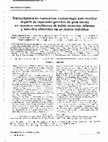
Gaceta medica de Mexico
We describe the methodology used to analyze multiple transcripts using microarray techniques in s... more We describe the methodology used to analyze multiple transcripts using microarray techniques in simultaneous biopsies of muscle, adipose tissue and lymphocytes obtained from the same individual as part of the standard protocol of the Genetics of Metabolic Diseases in Mexico: GEMM Family Study. We recruited 4 healthy male subjects with BM1 20-41, who signed an informed consent letter. Subjects participated in a clinical examination that included anthropometric and body composition measurements, muscle biopsies (vastus lateralis) subcutaneous fat biopsies anda blood draw. All samples provided sufficient amplified RNA for microarray analysis. Total RNA was extracted from the biopsy samples and amplified for analysis. Of the 48,687 transcript targets queried, 39.4% were detectable in a least one of the studied tissues. Leptin was not detectable in lymphocytes, weakly expressed in muscle, but overexpressed and highly correlated with BMI in subcutaneous fat. Another example was GLUT4, whi...
Journal of Neurogastroenterology and Motility, 2012
Title of the paper was mis-typed. The correct title is "Physicians and Patients Measure Different... more Title of the paper was mis-typed. The correct title is "Physicians and Patients Measure Different Dimension on Assessment for Gastroesophageal Reflux Disease-related Symptoms." And title of the figure was incorrectly written. The correct title of the figure is "Symptoms improvement after 4 weeks of treatment with pantoprazole magnesium. (A) It shows patient evaluation with ReQuest TM. (B) It shows physician evaluation with a structured interview, despite the lack of correlation both measurements improved significantly with treatment. Both assessments showed significant amelioration of symptoms (P< 0.05 for all variables).

Journal of Neurogastroenterology and Motility, 2011
Background/Aims Gastroesophageal reflux disease is a highly prevalent disease. Assessing treatmen... more Background/Aims Gastroesophageal reflux disease is a highly prevalent disease. Assessing treatment efficacy is critical in that clinical endpoints are properly evaluated. Clinical tools for symptoms severity assessment should be discriminative, predictive and evaluative. Methods In this study we compared a patient-oriented symptoms evaluation (ReQuest TM) vs a structured interview assessment initiated by a physician (sickness impact profile [SIP]). Both questionnaires were analyzed in a multidimensional space using latent factors. Five dimensions were found: 1 for the short ReQuest TM questionnaire and 4 for SIP. Results We included 1,522 women and 1,296 men; mean age was 36 ± 7 years, and mean body mass index was 26 ± 4. The score questionnaire assessment evaluation by physicians and patients did not correlate between them (between r = 0.03 and 0.26) except nausea and sleep disorder (r = 0.45 and 0.51) but both were sensitive enough to detect changes after treatment (P < 0.05). Medical specialty of the physician showed effect on the score of both, ReQuest TM and SIP evaluation. Questionnaire variance decomposition due to specialist was only 2% (P < 0.05). Conclusions While both evaluations are orthogonal (non-correlated), meaning patients and physicians measured diverse aspects of the same disease, they both were able to measure patient's improvement with treatment.

Frontiers in Genetics, 2014
The prevalence of type 2 diabetes (T2D) is rising rapidly and in Mexicans is ∼19%. T2D is affecte... more The prevalence of type 2 diabetes (T2D) is rising rapidly and in Mexicans is ∼19%. T2D is affected by both environmental and genetic factors. Although specific genes have been implicated in T2D risk few of these findings are confirmed in studies of Mexican subjects. Our aim was to replicate associations of 39 single nucleotide polymorphisms (SNPs) from 10 genes with T2D-related phenotypes in a community-based Mexican cohort. Unrelated individuals (n = 259) living in southeastern Mexico were enrolled in the study based at the University of Yucatan School of Medicine in Merida. Phenotypes measured included anthropometric measurements, circulating levels of adipose tissue endocrine factors (leptin, adiponectin, pro-inflammatory cytokines), and insulin, glucose, and blood pressure. Association analyses were conducted by measured genotype analysis implemented in SOLAR, adapted for unrelated individuals. SNP Minor allele frequencies ranged from 2.2 to 48.6%. Nominal associations were found for CNR1, SLC30A8, GCK, and PCSK1 SNPs with systolic blood pressure, insulin and glucose, and for CNR1, SLC30A8, KCNJ11, and PCSK1 SNPs with adiponectin and leptin (p < 0.05). P-values greater than 0.0014 were considered significant. Association of SNPs rs10485170 of CNR1 and rs5215 of KCNJ11 with adiponectin and leptin, respectively, reached near significance (p = 0.002). Significant association (p 0.001) was observed between plasma leptin and rs5219 of KCNJ11.
Journal of Neurogastroenterology and Motility, 2014
Background/Aims To evaluate the effectiveness of pantoprazole magnesium (pantoprazole-Mg) 40 mg i... more Background/Aims To evaluate the effectiveness of pantoprazole magnesium (pantoprazole-Mg) 40 mg in the relief of esophageal and extra-esophageal symptoms of gastroesophageal reflux disease (GERD), particularly night-time symptoms. Methods Patients (aged 18-50 years) with 3-month history of heartburn and/or acid regurgitation plus at least one other symptom in the last week were enrolled in a nationwide, prospective and observational study in Mexico. Patients received pantoprazole-Mg 64

Medicine & Science in Sports & Exercise, 2011
We previously demonstrated that a 12-week periodized resistance training (RT) program results in ... more We previously demonstrated that a 12-week periodized resistance training (RT) program results in increases in strength, lean body mass (LBM) and resting energy expenditure (REE), decreases in total and trunk fat mass, and improvements in glucose tolerance, independent of weight loss in overweight, sedentary young adult men. In this study we investigated whether cessation of RT for 4 wks would result in the reversal of the changes noted with 12 wks of RT. METHODS: 25 sedentary overweight young adult men (body mass index, BMI 32.2±3) were instructed to stop RT for 4 wks following 12 wks of training at 3x/wk. After an overnight fast and abstaining from exercise for 72 hrs, subjects were assessed for changes in body weight, BMI, waist circumference (WC), 1-repetition maximum (1-RM) strength (leg press, chest press, and seated row), LBM, fat mass and trunk fat by dual energy X-ray absorptiometry (DXA), REE by indirect calorimetry, blood pressure, arterial stiffness by tonometry, fasting glucose, glycated hemoglobin (HbA1c), glucose tolerance (by oral glucose tolerance test, OGTT), plasma lipids (total cholesterol, low-density lipoprotein (LDL), high-density lipoprotein (HDL), non-HDL cholesterol and triglycerides (TG)) and serum biomarkers of cardiovascular disease (matrix metalloproteinase 9 (MMP-9), myeloperoxidase (MPO), soluble-E-selectin (sE-selectin), soluble intercellular adhesion molecule-1 (sICAM-1), soluble vascular adhesion molecule-1 (sVCAM-1), tissue plasminogen activator inhibitor-1 (tPAI-1) and adiponectin). PURPOSE: To examine benefits of 1y bone building exercise program on body composition, bone mineral density(BMD), bone turnover and muscle strength in early postmenopausal (<8 ys) women. METHODS: 32 compliant women, with no medication or illness affecting bone metabolism, voluntarily participated in the exercise group(EG); 30 women acted as nonexercise controls(CG).EG exercised 3-5 times weekly for 1y. BMD was measured by dual-energy x-ray absorptiometry(DEXA) at the lumbar spine, proximal femur and whole body. Body composition was derived from whole body DEXA scan. Bone turnover was determined from serum bone-specific alkaline phosphates (BAP), bone Glaprotein(BGP), Tartrate-resistant Acid Phosphatase 5b (TRACP-5b), and 25-hydroxy vitamin D (25(OH)D). Muscle strength was detected by the hip and waist's isokinetic muscle strength. Comparisons within and between groups were assessed with paired and independent-sample T tests. RESULTS: There were no significant differences between groups at baseline. After 1y, EG had remarkably decreased in weight, percentage body fat and fat mass (p<0.05; p<0.01; p<0.01), while no changes were found in CG. BMD and BMC in EG remained stable at all sites. BMD and BMC of femur neck greatly reduced in the CG (p<0.01; p<0.01), resulting in evident differences between the EG and CG (p<0.01; p<0.05). Relative BMC (BMC/weight) in EG markedly added at lumbar spine, total hip, femoral neck and greater trochanter(p<0.05; p<0.01; p<0.01; p<0.01), while CG had no obvious changes. BAP and TRACP-5b in EG had evidently increased(p<0.01; p<0.05), with no apparent variation being observed in 25(OH)D and BGP. CG showed no changes in markers of bone turnover. Peak-torque values for waist flexion and extension(30°/s), hip flexion(180°/s) and extension(90°/s) in EG had observably elevated(p<0.05; p<0.01; p<0.01; p<0.01), but no significantly alterations in CG. CONCLUSIONS: These findings suggest that bone building exercise program is feasible and effective to improve bone mass and muscle strength in early postmenopausal women and support the need for further human studies.
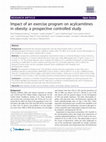
Journal of the International Society of Sports Nutrition, 2012
Background Acylcarnitine (AC) transport dysfunction into the mitochondrial matrix is one of the p... more Background Acylcarnitine (AC) transport dysfunction into the mitochondrial matrix is one of the pathophysiological mechanisms of type 2 diabetes mellitus (DM). The effect of an aerobic exercise (AE) program on this condition in obese subjects without DM is unclear. Methods A prospective, randomized, longitudinal, interventional study in a University Research Center involved a 10-week AE program in 32 women without DM and a body mass index (BMI) greater than 27 kg/m2. (Cases n = 17; Controls n = 15). The primary objective was to evaluate the influence of a controlled AE program on beta-oxidation according to modifications in short, medium, and long-chain ACs. Secondary objectives were to define the behavior of amino acids, and the correlation between these modifications with metabolic and anthropometric markers. Results The proportion of dropouts was 17% and 6% in controls and cases, respectively. In cases there was a significant reduction in total carnitine (30.40 [95% CI 28.2 to 35...
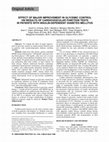
Endocrine Practice, 1998
Objective: To evaluate the effect of major improvement in glycemic control on cardiovascular func... more Objective: To evaluate the effect of major improvement in glycemic control on cardiovascular function tests in patients with insulin-dependent diabetes mellitus (IDDM). Methods: Eight men with chronic, poorly controlled IDDM (serum fructosamine >300 µmol/L and mean fasting blood glucose >200 mg/dL), who were 24 ± 6 years of age and had a mean duration of diabetes of 8 ± 1 years, were studied. No patient had microalbuminuria, was taking medication other than insulin, or had evidence of heart disease. Patients underwent baseline continuous ambulatory blood pressure monitoring, echocardiographic studies, and cardiovascular autonomic function tests, which were repeated after 4 weeks of an intensified insulin treatment program (IITP), during which they reached and maintained blood glucose concentrations and serum fructosamine levels in near-normal, nondiabetic ranges. Results: Substantial changes in glycemic control had no significant influence on results of ambulatory blood pressure monitoring, cardiovascular autonomic function tests, and echocardiographic studies. Conclusion: Major improvement in glycemic control during a 1-month period in patients with IDDM had no significant influence on cardiovascular function tests. We cannot exclude the possibility that, after a longer duration of an IITP or in patients with clinically evident heart disease or evidence of major complications of diabetes, different responses might be observed.
… . Parte I de III: de la …, 2009
Dermatología Rev Mex Volumen 53, Núm. 4, julio-agosto, 2009 ... La raíz del protocolo de investig... more Dermatología Rev Mex Volumen 53, Núm. 4, julio-agosto, 2009 ... La raíz del protocolo de investigación. Parte I de III: de la cacería de las ... Juan Carlos López Alvarenga,* Lucía Monserrat Pérez Navarro,** Sergio Sobrino Cossio*** ... * Southwest Foundation for Biomedical ...

Archives of Medical Research, 2009
Background and Aims-Several studies have demonstrated overweight and obesity are strong independe... more Background and Aims-Several studies have demonstrated overweight and obesity are strong independent risk factor of GERD symptoms and esophageal erosions. Our aim was to analyze the joint effect of BMI with the grade of esophageal damage over symptoms' intensity of GERD. Methods-We used a questionnaire with a Likert scale for severity of symptoms related to GERD. The distal portion of the esophagus was evaluated to determine the presence of mucosal injury, classified by Los Angeles criteria (LA). Results-We included 917 subjects (53.76% females) with average age 36.8 ± 7 years. Males had higher BMI than females (26.8 ± 3.5 vs. 25.2 ± 4.5, p <0.001). Severe damage (C-D ulcers) was associated with overweight (BMI 25-30), severity of heartburn, retching, halitosis, regurgitation, and chest oppression. BMI >30 had high score for heartburn and retching, but low score for nausea, compared with lower weight. The model with interaction showed a non-linear association between BMI and LA. Overweight (but not obese) patients with damage scored C-D had the highest score for intensity of heartburn and retching. Conclusions-BMI and LA do not have additive effects on the severity of symptoms of GERD. Those with BMI between 25 and 30 had severe symptoms score, but those with BMI >30 showed lower scores. These findings could explain controversial results found in other studies.
Canadian Journal of Cardiology, 2015

Uploads
Papers by Juan Lopez-alvarenga